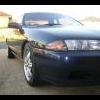World's Largest Engine
Announcements
-
Similar Content
-
Latest Posts
-
I am using Motec M150. I am not working on the car myself actually. My workshop is giving all these info, they are quite reputable in the industry and are very familiar with Motec and RBs and have done a few big setups with VCam and single turbo on RBs. In fact, they built and tuned my engine from day one. But they are stumped with my engine at the moment and cannot work out how come the compression is so low with the VCam. They told me that they have now swapped in some Kelford cams (without the VCam) and can achieve around 130psi compression and the low end torque is better, but now the engine is doughy as. It boosts and peaks at more than 1000rpm slower, with twin HKS GTIII RS, it doesn't get full boost until over 5000rpm. I have always thought the VCam was a bit disappointing at the low rpm. To a point I had to ride the clutch a fair bit to get up a small hill from stand still. That was when I had a clutch. Now changing to a 8HP, I don't have that luxury and this problem has become a major issue. I am beginning to think the VCam never work since the day it was installed. Maybe it was just sitting at the most advanced point, that is why it went good at top end but very ordinary at the bottom. Therefore, with the help of the Holinger 6 speed and paddle shift, as long as it was moving, it drove pretty good.
-
By Dose Pipe Sutututu · Posted
yeah, there's a country that recently started importing Skylines, I blame them. -
I don't have a printer, but could at least attempt to make a printable model.
-
If you do make them, im sure you would have a number of buyers.. Every GTR I've been in have rattly door windows
-





Recommended Posts
Create an account or sign in to comment
You need to be a member in order to leave a comment
Create an account
Sign up for a new account in our community. It's easy!
Register a new accountSign in
Already have an account? Sign in here.
Sign In Now